What is Japanese Tanegashima Gun (hinawajū)?
Contrary to popular belief, the samurai's armory extends beyond their renowned katana and traditional samurai armor; they are also skilled users of firearms, a testament to their adaptive combat abilities. Matchlock guns in Japan, also called Tanegashima Gun, hinawajū. It was arrived on Tanegashima during the Sengoku period and greatly influenced the Japanese warfare.
This article will explain how these weapons actually spread across Japan and discuss their mechanisms and how to use them. If you're interested in owning a matchlock gun, we will also cover that topic.
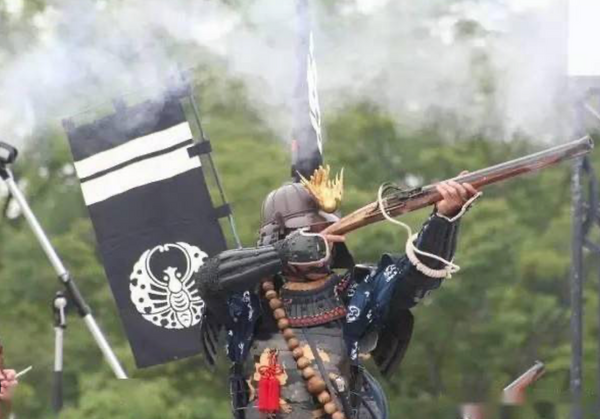
Table of Content
- What is Japanese Tanegashima Gun 種子島(hinawajū)?
- Tanegashima Gun History
- Tanegashima Gun Parts
- Use of Tanegashima Guns in Battle
What is Japanese Tanegashima Gun 種子島(hinawajū)?
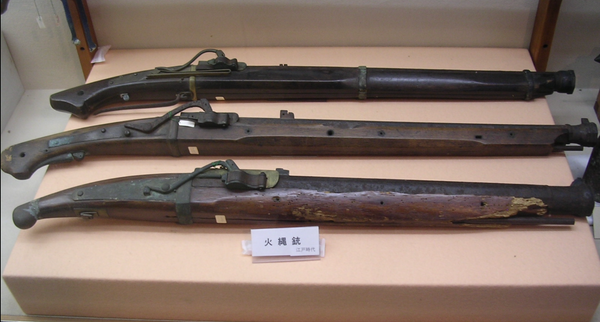
Tanegashima Gun is essentially a matchlock Gun, it is a type of antique firearm developed around the 15th century. It's one of the earliest firearms developed by mankind, equipped with a smoothbore barrel (a barrel without rifling) and a mechanism to fire metal bullets instantaneously by burning black powder. It was developed in Europe around the early 15th century and evolved in Austria and Germany. Typically, a matchlock gun with a barrel length of about 1 meter is said to have a maximum range of over 500 meters, and an effective range of about 100 meters for hitting a target the size of a human body. It is also said to be able to hit a target about the size of a baseball at a distance of about 30 meters.
Tanegashima Gun History

The Tanegashima Gun was first introduced to Japan through Portuguese merchants. In 1543, on Tanegashima (種子島) Island (Kagoshima Prefecture), a merchant ship with two Portuguese arrived. Tokitaka Tanegashima, the lord of Tanegashima at that time, hospitably received the Portuguese and purchased the two matchlock guns for a substantial sum. In return, the Portuguese merchants demonstrated a test firing of the matchlock guns.
Tokitaka Tanegashima then lent one of the purchased matchlock guns to a swordsmith on Tanegashima, instructing him to replicate it. Within about a year, they successfully begin the production of these firearms locally in Japan. This is why it's called Tanegashima gun.
There's another theory suggesting that matchlock guns, which had already spread to Southeast Asia, China, and Korea, were brought into various parts of Japan by Wokou (倭寇 Japanese pirates). Either way, it is certain that they started flowing into Japan by the middle of the 16th century. At that time, Japan was in an era of civil war, which created a lot of demand for guns, and thanks to the prosperous mining of gold and silver, guns spread throughout Japan quickly.
Tanegashima Gun Production in Japan
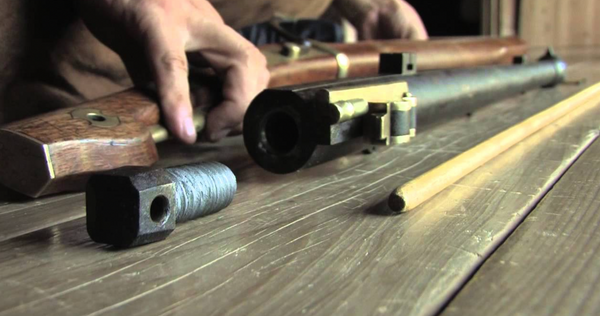
While Portugal had established a gun factory in India in the 16th century, not all of the matchlock guns that spread in Japan were produced there. The manufacturing method for the matchlock guns also made its way to Japan. Therefore, Japan was able to replicate and operate them independently.
Matchlock guns had a complex mechanism that was not present in Japan at the time, requiring the creation of metal parts and refining gunpowder. Among them, screws were said to be particularly difficult to make. Tokitaka Tanegashima, the lord of Tanegashima, ordered the swordsmith Yasaka Kinbei to replicate a matchlock gun. At that time, the only tools available for metalworking were chisels and files. Yasaka Kinbei made various improvements and succeeded in creating intricate screws after a year, leading to mass production of Tanegashima Gun.
Tanegashima Gun became widespread, and the number of guns owned in Japan became the highest in the world. Ruled by Oda Nobunaga, Kunisada transformed from a town of swordsmiths to a town of gunsmiths, becoming the largest gun production area in Japan. In addition to Kunisada, places like Sakai (Osaka Prefecture) and Saiga (Wakayama Prefecture) also actively produced matchlock guns.
Due to the high skill level of Japan's swordsmiths, they were able to make guns with higher accuracy than those made in Europe. Moreover, they succeeded in mass production in a short period of time. For example, 3,000 guns (some sources say 1,000) were used in the Battle of Nagashino in 1575, and it is said that the Tokugawa army prepared as many as 300,000 firearms, including matchlock guns, for the Siege of Osaka in 1614. By the end of the Sengoku period, there were probably as many as 500,000 guns in Japan, making it the country with the most guns in the world.
Tanegashima Gun Parts
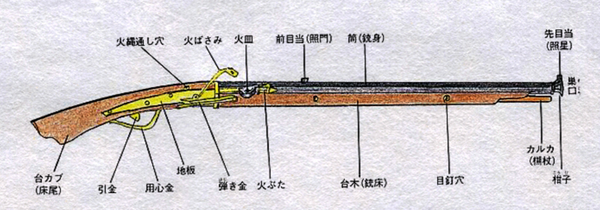
The matchlock guns transmitted to Tanegashima featured a matchlock (火縄式, hinawa-shiki) ignition mechanism, which involved loading bullets and gunpowder into the muzzle for firing. These guns were composed of three main components: the barrel, the stock (銃床, jūshō), and the firing mechanism, known as the karakuri.
Initially, the matchlock guns introduced to Tanegashima lacked a supporting stock for the barrel, but later models were designed with a stock. The primary components of these guns are as follows:
Touch Hole (火縄通しの穴, hinawa-tōshi no ana): A hole for passing through the match, which serves as the ignition source.
Serpentine (火ばさみ, hibasami): A device that clamps the end of the match inserted through the touch hole.
Pan (火皿, hibachi): A dish for holding the priming powder.
Pan Cover (火ぶた, hibuta): A lid used to close the pan.
Ramrod (カルカ, also known as 朔杖, sakujō): A rod utilized for packing the bullet and gunpowder into the barrel.
Front Sight / Rear Sight (前目当 / 先目当, maemokuatte / sakimokuatte): Devices used for aiming purposes.
The principle behind the matchlock gun and modern guns is the same: they fire metal bullets using the explosive force of gunpowder. In the barrel, a screw called a breech plug is fitted at the bottom, and the gunpowder and bullet are set inside. The part where the gunpowder is filled is called the chamber, which is connected to the pan outside the barrel. Priming powder is placed in the pan, and the fire on the matchcord is introduced, igniting the priming powder, which in turn ignites the gunpowder in the chamber. The gunpowder explodes in the chamber, and this force propels the bullet.
How to Use the Tanegashima Gun
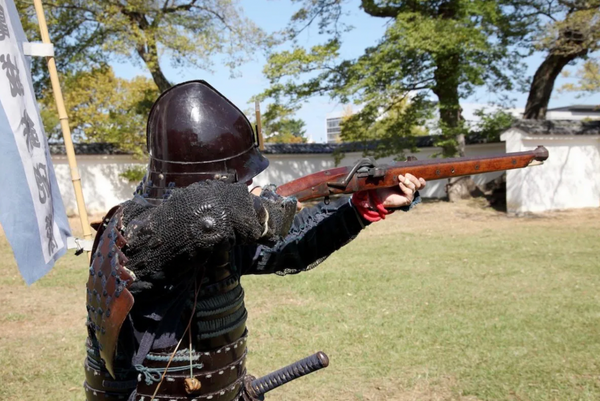
To use a matchlock gun, several steps are required. Because it takes more effort than modern guns, innovative methods were needed when using it on the actual battlefield:
Ignite the matchcord: Light the matchcord so that it can be fired at any time. In some cases, multiple cords would be lit.
Load gunpowder and the bullet into the barrel: Insert gunpowder and a bullet from the muzzle, and push them in using the ramrod.
Put priming powder into the pan and close the pan cover: Pile finely-grained priming powder in the pan, which is more granular than the gunpowder put into the barrel, and close the pan cover to protect it.
Attach the matchcord to the serpentine: Fix the matchcord to the serpentine and prepare to fire.
Cut the pan cover (open it), pull the trigger, and fire: When the trigger is pulled, the lit matchcord strikes the pan, igniting the gunpowder in the chamber, and the bullet is fired.
Use of Tanegashima Guns in Battle

When the matchlock gun first arrived, it was an expensive weapon used by top-level generals. As mass production increased and the weapon became more widespread, it became the primary weapon of Ashigaru, the foot soldiers. A gun, once you learn how to fire it, can inflict damage on an enemy much further away than a spear, so there is no doubt it became a formidable threat in battle.
One of the most famous battles using matchlock guns was the Battle of Nagashino in 1575, where the combined forces of Oda Nobunaga and Tokugawa Ieyasu fought against the Takeda Army. According to popular theory, Nobunaga used 3,000 guns and performed a three-step firing procedure using horse barricades, defeating the Takeda cavalry. Although there are debates about the number of guns used and the three-step firing procedure, it is generally agreed that matchlock guns are the key to win.
Moreover, there were famous matchlock gun experts like Akechi Mitsuhide and a group of mercenary riflemen called the Saika-shu, who were touted as the strongest in the Sengoku period. There is no doubt that the presence of matchlock guns became a necessary element in shaping history during the Sengoku period.
Tanegashima VS Samurai Armor
Initially, Samurai armor struggled against the penetrating power of Tanegashima bullets. However, recognizing this vulnerability, Japanese armorers took inspiration from European plate armor and began to innovate. They developed thicker chest pieces, robust enough to withstand the impact of Tanegashima bullets. Although the cost of producing such armor was high, the need for effective protection in the evolving landscape of warfare made this a necessary and valuable advancement.
Types of Matchlock Guns

The standard matchlock gun had a length of approximately 130cm. In addition to this, there were several specialized versions: the "Samazutsu" (狭間筒), designed for use in ships or castles; the "Bajouzutsu" (馬上筒), a shorter firearm that could be operated with one hand while on horseback for close combat; the "Tanzutsu" (短筒), a compact gun for self-defense that could be concealed in one's clothing; and the "Oodeppou" (大鉄砲), known for its powerful impact. These variations reflected the adaptability and innovation of Japanese craftsmen in response to the diverse requirements of warfare during that era.





















